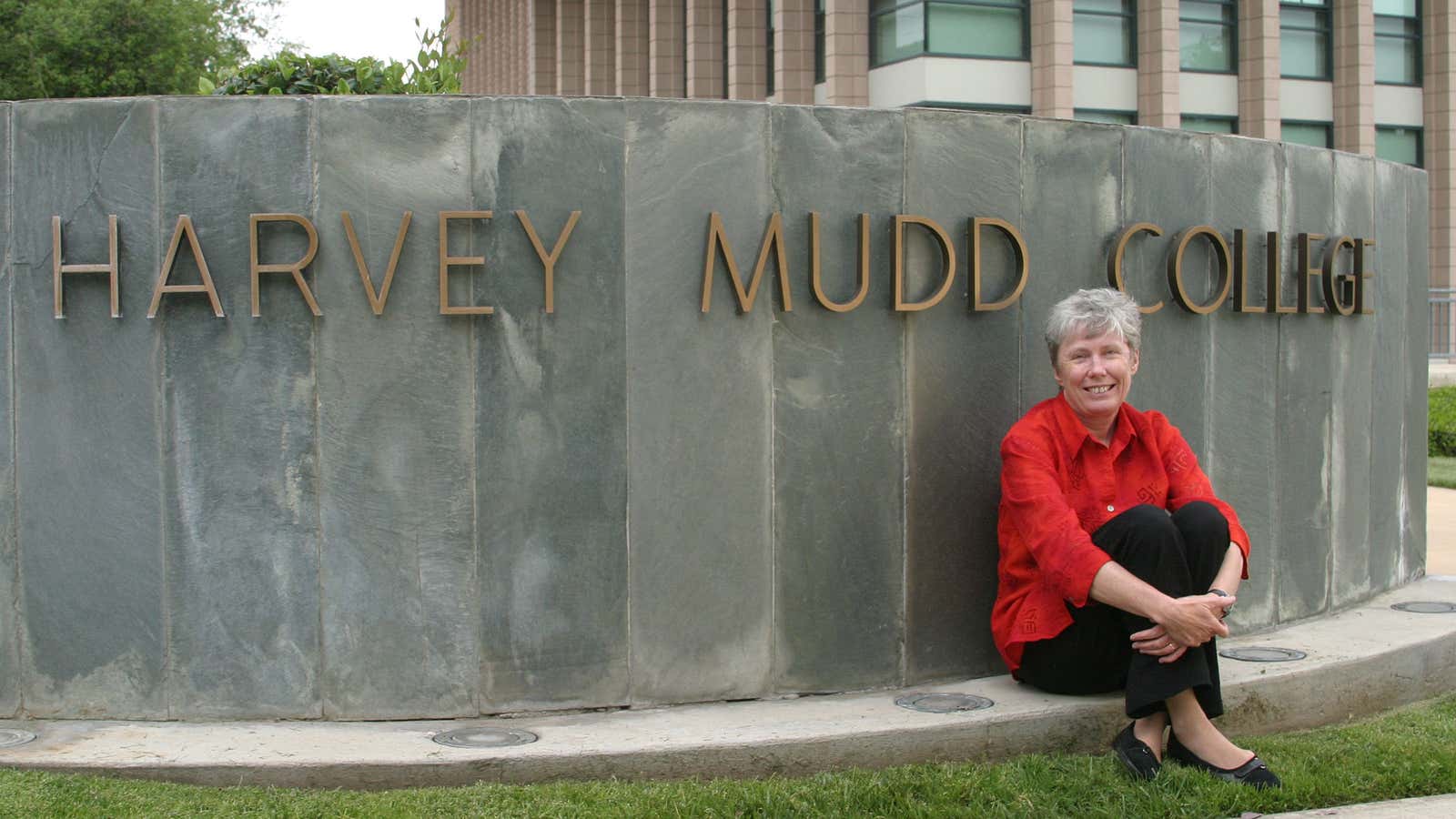As US universities struggle to encourage women to study computer science, one small college is having uncommon success attracting them to the field.
Harvey Mudd College, in Claremont, California, has been an outlier in producing female programmers for a decade. This year, for the first time, more women than men graduated with a degree in computer science. Nationally, about 16% of undergraduate computer-science majors are women. At Harvey Mudd, that figure is 55%. (It falls to 49% when joint majors are included.)
It has done it by removing obstacles that have typically barred women—including at the faculty level. The school emphasizes teaching over research, hiring and rewarding professors on the basis of their classroom performance, says Maria Klawe, Harvey Mudd’s president since 2006. And it places women in leadership positions throughout the school. Next year, six of the school’s seven department chairs, and 38% of its professors school-wide, will be women.
The overhaul of the computer science curriculum to make it more inclusive began the year before Klawe arrived from Princeton, where she was the dean of engineering. The school had redesigned its introductory course, required for all first-year students, to emphasize practical uses for programming and team based-projects, and switched from the Java programming language to Python, which more closely mimics the way humans communicate. The course is broken into three tracks, including one for students with no programming background.
To make everyone feel at ease, professors urge know-it-all students who always have their hand in the air to talk during office hours, instead of in class.”Too often, people with experience are taking up all the air time,” Klawe says.
As a result of the changes, women who take the introductory course are more likely to leave with a positive impression of programming, and often sign up for the second class in the sequence. Many go on to internships or research projects in the field after their first year, and by then, they’re hooked.
It helps that Mudd, named after a mining engineer who helped found the school, is so small. With only 800 students, there are fewer opportunities to slip through the cracks. And because virtually everyone in the school majors in a STEM (science, technology, engineering, and math) subject, women studying those fields at Harvey Mudd are less likely to feel marginalized.
Jean Sung, 21, a recent graduate who accepted a job at Facebook, chose Mudd over Cornell’s college of engineering, in part because of the gender mix. It was a big change from her high school computer-science classes in Woodinville, Washington, where she felt more pressure to succeed—whereas the number of women in the classroom at Mudd allowed her to relax, she says.
“For me in high school, if I got something wrong, I felt it would be more of a reflection on women in the class,” she says. “When I got to Mudd, it was nice to see not just women, but women at the top of the class, women in the middle, and women at the bottom. At Mudd, I felt average, and Mudd gives you space to feel average.”
It’s not just in computing where women at Mudd are thriving. This year, women graduated with the majority of physics degrees, too.
Mudd’s nurturing environment comes with a cost—literally. The school is ranked as one of the most expensive in the US, with annual tuition of $52,383 and a total cost of attendance—including meals, housing, and books—of $71,917. Klawe says that about three quarters of students receive some form of financial aid, and admission is need-blind for US applicants.
Mudd’s success with women has gotten attention from other colleges and universities, and in 2014, Klawe and Mudd helped launch the BRAID (Building, Recruiting and Inclusion for Diversity) Initiative to promote women and minorities in computer science at other institutions. Fifteen universities, from Arizona State to the University of Vermont, are taking part and receiving funding from the tech industry to send female students to women-in-computing conferences.
The New Jersey Institute of Technology, one of the BRAID schools, has sent female graduate students to local high schools to talk with girls about computer science, toured tech employers like Facebook, and offered free programming courses to high school teachers, says James Geller, a professor leading the effort. This year, NJIT will send 18 students to Houston to attend the Grace Hopper Conference, billed as the world’s largest meeting for women in computing.
It’s too early to see changes in enrollment, Geller says, ”but we have seen a slow change in culture and awareness, both internally and in surrounding high schools.”
Meanwhile, the pathways for Mudd’s newly minted female graduates hint at the next places where change will unfold, including the tech industry itself.
More of Mudd’s women are translating their computer science degrees into careers in tech. This year, 64% of women who reported having accepted a full-time job at graduation had a position in the technology industry. That’s up from 30% in 2011. They tend to choose large employers like Google, LinkedIn, and Intel, where there’s more stability than startups, Klawe says. And Mudd has one of the highest rates of graduates earning PhDs of all colleges, suggesting there’s a continued opportunity for Mudd to influence the highest levels of academia, far beyond its own campus.
